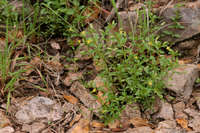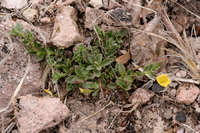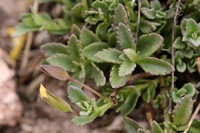Duration: Perennial
Nativity: Native
Lifeform: Forb/Herb
General: Creeping or ascending glabrous herbs, branching at base, sometimes rooting at lower nodes, branches to 15 cm long, flexuous, stems strongly angled.
Leaves: Opposite, ovate, mostly 10-15 mm long, 8-10 mm wide with 7 even, ascending teeth on upper two-thirds of margin, apically obtuse, basally cuneate, glandular punctate with sessile glands, short or indistinct petiole.
Flowers: At first terminal, soon axillary, a solitary flower in leaf axil, on slender pedicels, with bracts 2-4 mm long, linear entire, located at base of pedicel; flowers 8 mm long, 5 -lobed, lobes recurved, rounded, yellow, bearded in throat with darker veins; 4 stamens.
Fruits: Capsule narrowly ovoid, about 4 mm long, dehiscent loculicidally and septicidally from apex.
Ecology: Found in wet, sandy soil along streams from 3,000-4,500 ft (914-1372 m); flowers March-September.
Notes: Its opposite leaves and slightly dentate margins will help steer identification toward Phrymaceae and Mimulus, but pay attention to the way the flower emerges from what appears to be a sheath.
Ethnobotany: Unknown
Etymology: Mecardonia is named for the Spaniard Antonia de Meca y Cardona, a patron of botany, while procumbens means having trailing or prostrate stems.
Synonyms: Mecardonia dianthera, M. peduncularis, M. tenuis, M. vandellioides
Editor: SBuckley, 2010













